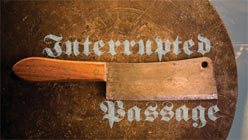On September 11, 2001, we woke up early to look at winter rentals at Higgins Beach. We drove through the southern Maine morning, leaves turning, until we arrived at the small strip of houses along the ocean. Standing in gravel driveways, peeking into the windows of wooden houses, gray boards cracked and bowed, I remember the clear sky and the cold air from the sea. The morning is crystallized in my mind, like a scene inside a snow globe. These were the hours before everything changed, before we drove back into town and walked past a television store and saw the images of the World Trade Center on a screen facing the sidewalk. Sometimes I want to return to that morning by the ocean, to marvel at our innocence and inaccurate visions of the future, to search for clues of what was to come. Maybe I would be able to find the moment that “before” turned into “after.”
We are constantly negotiating between the past and the future, stumbling through the moments that connect old versions of our world with emerging ones, revising our memories to reflect then-future events. We can’t see tomorrow. Julio Cesar Morales’ current exhibit at New Langton Arts takes this relationship — between history and what’s to come — as its subject. As in the rest of Morales’ practice, the artist grounds his explorations in the cross-border dynamics of the United States and Mexico. tomorrow is for those who can hear it coming consists of three works that, as Morales says in an interview with curator Maria del Carmen Carrion, seek to “go to the future by going back to the past.”
The most provocative of the pieces is Interrupted Passage, a meticulously detailed reenactment of General Vallejo’s 1846 meeting with members of the U.S. militia. As a result of the meeting, which took the form of a meal, the Treaty of Guadalupe was signed, and California joined the United States. The video, which plays at New Langton on a loop, was filmed at Casa Grande, Vallejo’s historic home in Sonoma. The reenactment does not profess to be literal or historically definitive, rejecting the nostalgia of typical historical reenactments. Bare of dialogue, its only accompaniment is an ambient electronic soundtrack. The characters are theatrical, their costumes obvious, their facial expressions unnatural. “It is not an accurate vision, it is not a reenactment in that sense,” Morales said in his conversation with Carrion. He continued: “It is something that I envisioned related to my reading of Vallejo’s autobiography — what he was thinking, how he was feeling, and what those last eight hours could have looked like.”
Morales, as Vallejo, sits sideburned and uneasy in his home awaiting his guests. Other characters — two bearded and rough looking soldiers — approach. The meal begins. The camera focuses on hungry slurps and tense looks. We never see a piece of paper signed or witness a conversation among the men. The scene merely builds and builds, the music beats and pulses, approaching a future climax the viewer never sees. While one screen shows the meal being eaten, a second screen provides footage of its preparation. Onions are chopped with a cleaver and a steer is roasted above a fire. Sensual and visceral, the food appears as a sacrifice. Although Morales admits the filmed reenactment is not historically accurate, he went to great lengths to ensure the meal was, collaborating with chef Max La Riviere-Hedrick to create a meal out of ingredients available during Vallejo’s time.
Morales’ vision of the past is one heavily influenced by and relevant to the issues of today. Vallejo had an open immigration policy, Morales points out. “He wanted people to come to Alta California…I thought it was an interesting connection to make in our current political climate, when as we speak, the wall between Mexico and the United States is being built.” Strangely, the food prepared and eaten in Interrupted Passage serves as a link between those two time periods. Immediate and sensual, the food provokes an awareness of the present, of this moment, right now. The moment after a memory and before the next step.


